Chapter 14
Evolution & Natural Selection
...
Charles Darwin (1809–1882)
- Charles Darwin (1809–1882)
- English naturalist who first suggested an explanation for why evolution occurred
- Published in 1859, On the Origin of Species by Means of Natural Selection
- Charles Darwin’s work on evolution challenged established worldviews
- Darwin proposed a mechanism for evolutionary change called natural selection
- Darwin’s hypothesis for evolutionary change, after much testing, eventually became accepted as theory
natural selection
Darwin proposed a mechanism for evolutionary change called natural selection
- Darwin voyaged from 1831–1836 on the HMS Beagle, a ship mapping the world’s coastlines
- Darwin observed firsthand different plants and animals in various locales
- These observations played an important role in the development of his thoughts about the nature of life on earth
The five-year voyage of HMS Beagle
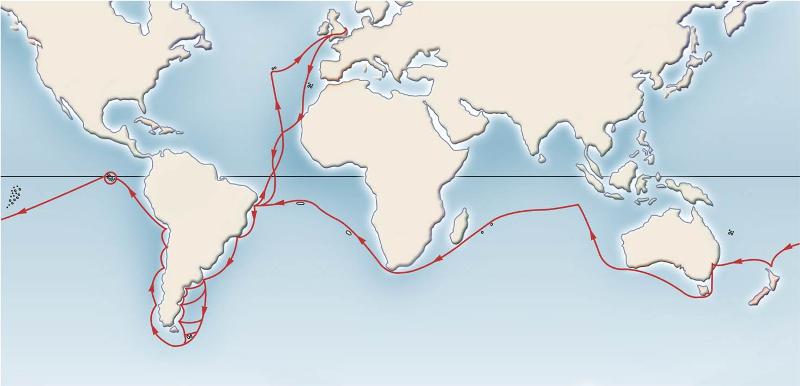
Darwin made several observations that helped lead him to believe that species evolve rather than remain fixed
1)fossils of extinct organisms resembled those of living organisms
2)geographical patterns suggested that organismal lineages change gradually as individuals move into new habitats
3)islands have diverse animals and plants that are related to, yet different from, their mainland sources
“descent with modification.”
Darwin observed that, although all the finches shared a common ancestor, their beak sizes had evolved to suit their food. Darwin termed this “descent with modification.”
The Theory of Natural Selection
- Thomas Malthus’ Essay on the Principle of Population (1798) provided Darwin with a key insight
geometrically
arithmetically
while human populations tend to increase geometrically, the capacity for humans to feed this population only grows arithmetically
Geometric and arithmetic progressions
What happens to a population when this gap between population density and resource availability gets wider?
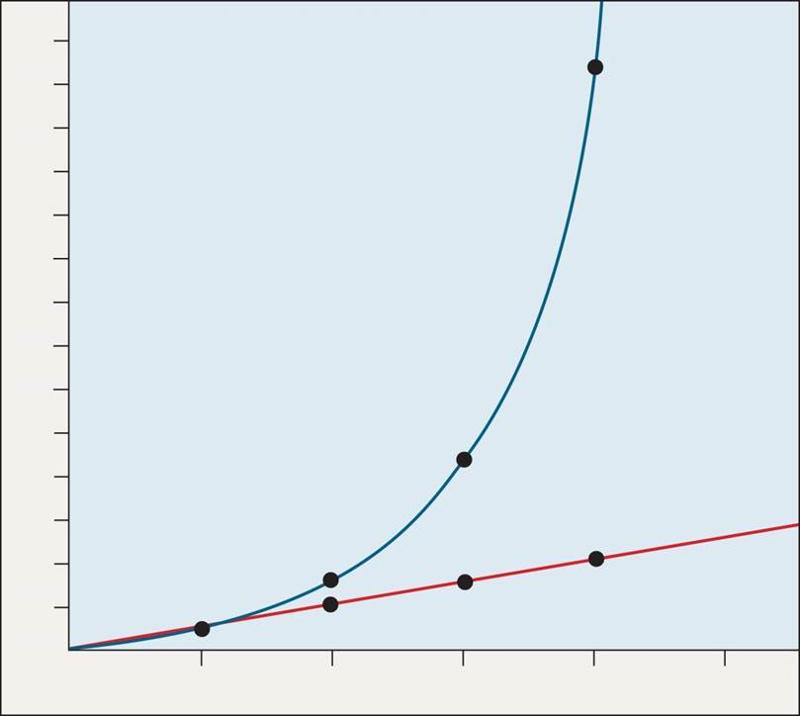
Darwin expanded Malthus’ view to include every organism
Darwin expanded Malthus’ view to include every organism
- all organisms have the capacity to over-reproduce
- only a limited number of these offspring survive and produce the next generation
Darwin associated survivors with having certain physical, behavioral, or other attributes that help them to live in their environment
- by surviving, they can pass their favorable characteristics on to their own offspring
natural selection
Darwin envisioned the frequency of favorable characteristics increasing in a population through a process called natural selection
- favorable characteristics are specific to an environment; they may be favored in one but not in another
- organisms whose characteristics are best suited to their particular environment survive more often and leave more offspring
Darwin’s selection concept is often referred to as the
Darwin’s selection concept is often referred to as the “survival of the fittest”
- Darwinian fitness does not always refer to the biggest or the strongest
- fitness, in evolutionary theory, refers to organisms who, due to their characteristics, survive more often and leave more offspring
Domesticated animals evolved through selective breeding for certain traits that breeders preferred. Darwin termed this form of selection
- the resulting differences between breeds of domesticated species are more extreme than what exists in nature
- Darwin termed this form of selection artificial selection, because breeders determined which traits were successful, rather than nature
Darwin drafted his ideas
- Darwin drafted his ideas in 1842 but hesitated to publish them for 16 years
- Darwin finally published On the Origin of Species in 1859
Another researcher, Alfred Russel Wallace, sent an essay to Darwin outlining a theory of evolution by natural selection
- Wallace had independently arrived at the same mechanism for evolution that Darwin had
- Darwin arranged for a joint presentation of their ideas in London
- Darwin finally published On the Origin of Species in 1859
- Darwin’s 1859 publication ignited controversy
- But the scientific community soon accepted Darwin’s arguments
Darwin’s finches are a closely related group of distinct species
- all the birds are similar to each other except for the shape of their beaks
- genetic differences account for the physical differences in the beaks
- birds with larger beaks make more of a protein called BMP4
A diversity of finches on a single island
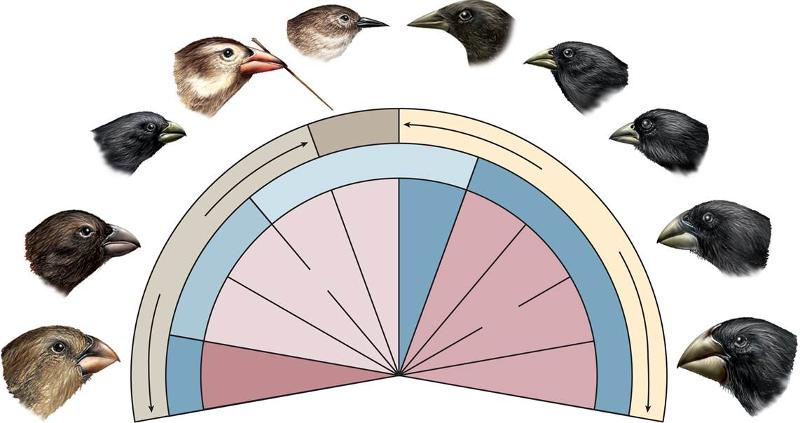
But David Lack’s (1938) study found
Darwin supposed that the birds evolved from a single ancestor to become individual species who specialized in particular foods
But David Lack’s (1938) study found that different species of finches fed on the same kind of seeds
does this contradict Darwin?
Peter and Rosemary Grant studied the medium ground finch on the island of Daphne Major in the Galápagos
They measured beak shape over many years and recorded feeding preferences
- the finches preferred to feed on small, tender seeds
- the finches switched to larger, harder-to-crack seeds when the small seeds became hard to find
- beak depth increased when only large, tough seeds were available
Evidence that natural selection alters beak size in Geospiza fortis
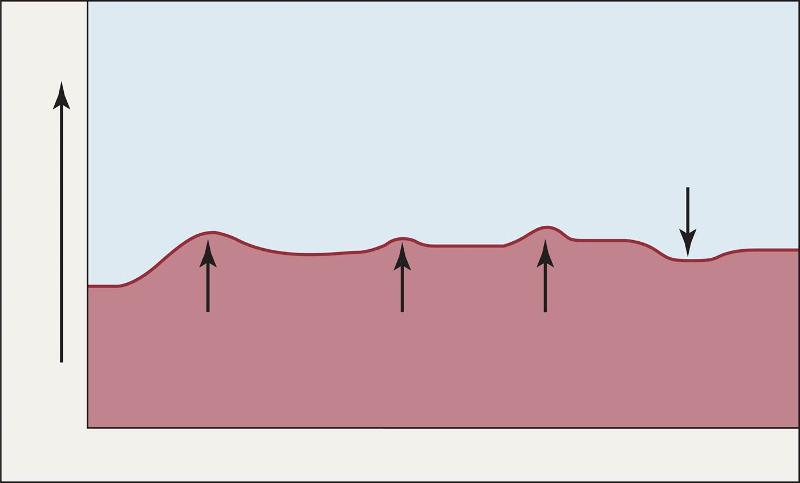
The Grants’ work with the medium ground finch is an example of
evolution in action
- average beak depth increased after a drought
- only large-beaked birds were able to crush the bigger seeds and survive to make the next generation
- when wet periods returned, smaller beaks prevailed at handling the then more plentiful small seeds
adaptive radiation
niches
- Darwin’s finches on the Galápagos are an example of adaptive radiation
in adaptive radiation, a cluster of species changes to occupy a series of different habitats within a region
each habitat offers different niches to occupy
- a niche represents how a species interacts both biologically and physically with its environment in order to survive
each species evolves to become adapted to that niche
fossil record
fossils
There are many lines of evidence supporting Darwin’s theory of evolution
- the fossil record comprises the most direct evidence of macroevolution
- fossils are the preserved remains, tracks, or traces of once-living organisms
- they are created when organisms or their traces become buried in sediment
- by dating the rocks in which the fossils occur, one can get an accurate idea of how old the fossils are
Fossils in rock represent a history of evolutionary change
Fossils in rock represent a history of evolutionary change
- fossils are treated as samples of data and are dated independently of what the samples are like
- successive changes through time are a data statement
- thus, the statement that macroevolution has occurred is a factual observation
The anatomical record also reflects evolutionary history
- Example: all vertebrate embryos share a similar set of developmental instructions and features
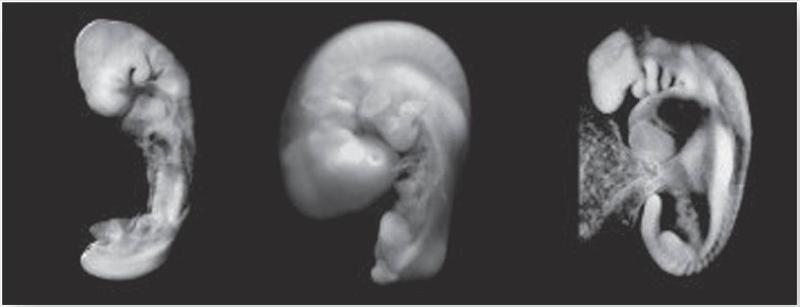
Homologous structures
Homologous structures are derived from the same body part present in an ancestor
- for example, the same bones might be put to different uses in related species
Analogous structures
convergent evolution
Analogous structures are similar-looking structures in unrelated lineages
these are the result of parallel evolutionary adaptations to similar environments
this form of evolutionary change is referred to as convergent evolution
Homologous versus Analogous Structures
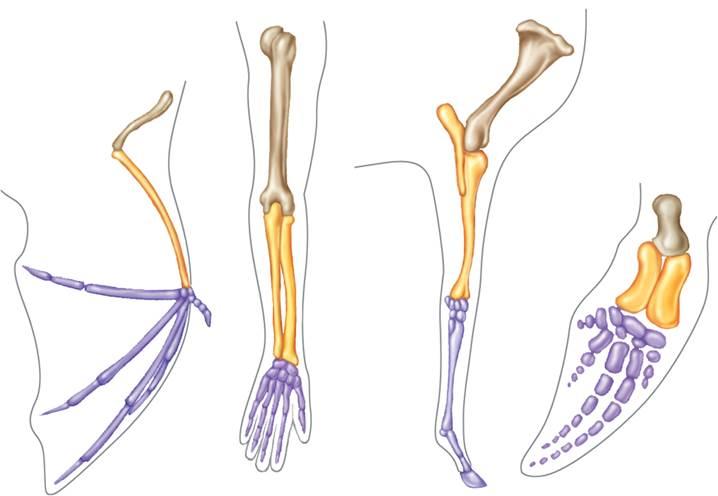
Homologous versus Analogous Structures
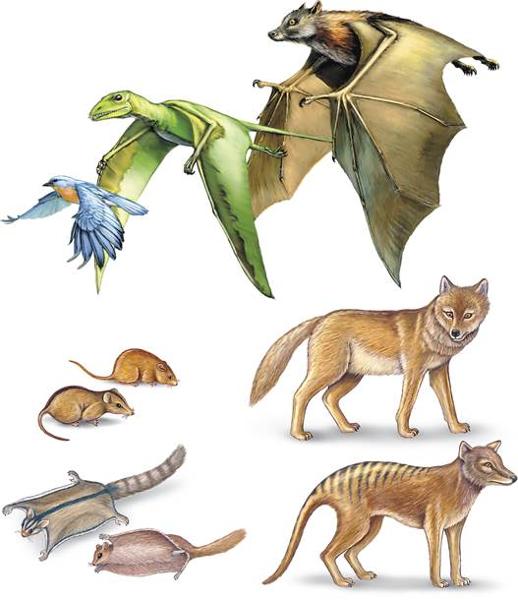
Traces of our evolutionary past are also evident at the molecular level
Traces of our evolutionary past are also evident at the molecular level
- organisms that are more distantly related should have accumulated a greater number of evolutionary differences than two species that are more closely related
- the same pattern of divergence can be seen at the protein level
Evolutionary changes appear to accumulate at a constant rate
molecular clock
cytochrome c
Evolutionary changes appear to accumulate at a constant rate
- this permits changes in an individual gene, compared over a broad array of organisms, to be dated from the time of divergence
- this dating is referred to as a molecular clock
- for example, changes have accumulated in the cytochrome c gene at a constant rate
The theory of evolution by natural selection is the subject of often-bitter public controversy
the controversy began soon after the publication of The Origin of Species but, by the turn of the 20th century, evolution was generally accepted by the world’s scientific community
more recent criticism has come from these sources
- the Fundamentalist Movement
- the Scientific Creationist Movement
- Local Action
- Intelligent Design
Critics have raised a variety of objections to Darwin’s theory of evolution by natural selection
These objections have either been refuted by biologists or do not necessarily reject evolution
- Evolution is not solidly demonstrated
- The intelligent design argument
- There are no fossil intermediates
- Evolution violates the second law of thermodynamics
- Natural selection does not imply evolution
- Life could not have evolved in water
An intermediate fossil
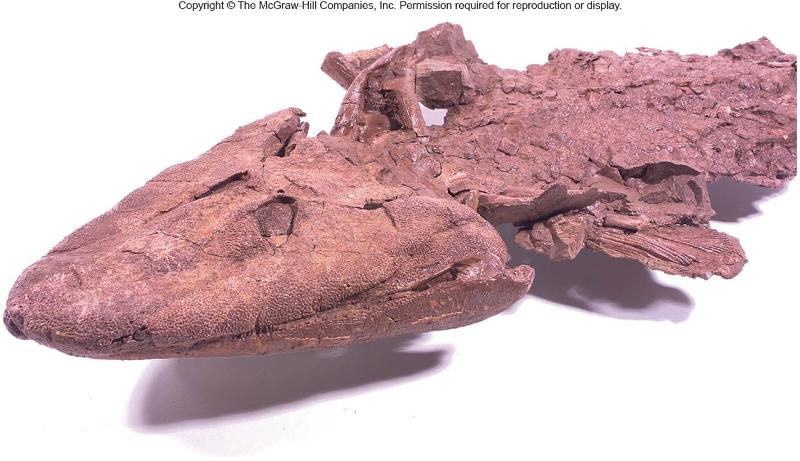
The irreducible complexity fallacy refers to claims by proponents of intelligent design that the molecular machinery of the cell is irreducibly complex
Yet natural selection has acted on the whole system: at every stage of evolution, parts that improve function are added, but the parts evolve together such that each one becomes essential
for example, the mammalian blood clotting system has evolved in stages from much simpler systems
...
Genetic Change In Populations: The Hardy-Weinberg Rule
Population genetics
Gene pool
Population genetics is the study of the properties of genes in populations
Gene pool is the sum of all of the genes in a population, including all alleles in all individuals
Hardy-Weinberg equilibrium?
Variation in populations puzzled many scientists
why don’t dominant alleles drive recessive alleles out of populations?
G.H. Hardy and W. Weinberg, in 1908, studied allele frequencies in a gene pool
- in a large population in which there is random mating, and in the absence of forces that change allele frequencies, the original genotype proportions remain constant from generation to generation
- because the proportions do not change, the genotypes are said to be in Hardy-Weinberg equilibrium
- If the allele frequencies are not changing, the population is not evolving
Genetic Change In Populations: The Hardy-Weinberg Rule
frequency
- Hardy and Weinberg arrived at their conclusion by analyzing the frequencies of alleles in successive generations
- frequency is the proportion of something compared to the total
- knowing the frequency of the phenotype, one can calculate the frequency of the genotypes and alleles in the population
Genetic Change In Populations: The Hardy-Weinberg Rule
By convention, the frequency of the more common of two alleles is designated by the letter p and that of the less common allele by the letter q
Because there are only two alleles, the sum of p and q must always equal 1
Hardy-Weinberg equilibrium equation
p2 + 2pq + q = 1
The Hardy-Weinberg equilibrium only works if the following five assumptions are met
- The size of the population is very large or effectively infinite
- Individuals can mate with one another at random
- There is no mutation
- There is no immigration or emigration
- All alleles are replaced equally from generation to generation (natural selection is not occurring)
Most human populations are large and randomly mated with respect to most traits and thus are similar to an ideal population envisioned by Hardy and Weinberg
for example,
for example, the frequency of heterozygote carriers for recessive genetic disorders can be estimated using the Hardy-Weinberg equilibrium